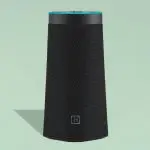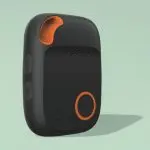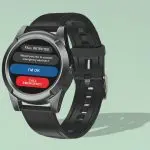Table of Contents
Key takeaways
- HandsFree Health offers three medical alert devices: the WellBe Medical Alert Speaker, WellBe Medical Alert Necklace, and WellBe Medical Alert Watch.
- All of these devices connect to the WellBe app, which helps users keep track of their medications, remember their appointments, and connect with their emergency contacts.
- The WellBe Medical Alert Necklace and Medical Alert Watch both offer fall detection for an additional $10 per month.
- Our testers find the Quick Start Guides included with the medical alert devices slightly vague. They have had to call HandsFree Health’s customer service representatives to fully understand the product features.
- All of the HandsFree Health medical alert devices allow two-way communication with monitoring centers, so users can get help in an emergency.
For many, aging at home is the ideal as they grow older. Roughly 27 percent of adults age 60 and older live alone in the United States. While living alone can increase feelings of independence, it does not come without risks. Depending on their physical health and living situation, some older adults may face challenges, such as a higher risk of falls. This can lead to the fear of falling, social isolation, and loneliness.
However, tools like medical alert systems allow users to stay connected to emergency monitoring centers and first responders so if there’s an emergency, they can get help quickly. These devices can also help older adults maintain their independence longer and give friends and family peace of mind.
“Physically, medical alert devices are lifesaving in situations where time is critical, such as falls, strokes, or heart attacks. Mentally, the impact of these devices is just as profound. The constant fear of ‘what if something happens?’ can hinder [older adults’] ability to fully enjoy life or even step outside their homes. With a medical alert device, that fear is reduced because they know that help is available at any moment,” says Maria Knöbel, a general practitioner and medical director at Express UK Medical Certificates Online.
For this review, we tested HandsFree Health, which offers three medical alert systems. Read on to learn more about each device and whether this brand is the best medical alert system for you.
Our verdict
HandsFree Health offers three medical alert devices: the WellBe Medical Alert Speaker, WellBe Medical Alert Necklace, and WellBe Medical Alert Watch. The speaker is for at-home use only, while the necklace and watch can be used on the go. Both of these devices offer fall detection for an additional $10 per month.
All of these systems have helpful features, including two-way communication with an emergency monitoring center, medication and appointment notifications, and entertainment options such as music, audiobooks, and the news.
Our main complaints with HandsFree Health are the brand’s Quick Start Guides, which are vague and often don’t contain the information needed to set up or understand all of the features included with these devices. Our testers have resorted to using online support pages and contacting HandsFree Health’s customer service representatives to gain more insight into these devices during testing.
HandsFree Health WellBe Medical Alert Speaker
Insights from our testers
The WellBe Medical Alert Speaker is a smart speaker that connects to the internet, bringing users 24/7 connectivity to a monitoring center in case there’s an emergency. You don’t have to worry if there’s a power outage because it backs up to a built-in lithium battery. When you first get the speaker, you’ll want to plug it in and download the WellBe app. Our testers love how this model allows you to program your medical history, insurance information, and upcoming medications or appointments. It will even send notifications to you and your care recipient, letting you know if medications or appointments were missed. It can also be programmed to contact loved ones during an emergency. Users can listen to music, audiobooks, and the news through the speaker, making it more dynamic than many other systems on the market. Our testers say the system can give you location-specific information, like the nearest urgent care center, and pertinent health information.
While setting up the Medical Alert Speaker is fairly easy, the Quick Start Guide included with the product is vague and does not outline all of the speaker’s features. Our testers have had to look up answers on online support pages or call HandsFree Health’s customer service team. For example, to trigger a call to emergency services, you press the red cross button and say something like, “Okay, WellBe, call emergency services.” However, these directions were not in the guide. But we do like how the app notifies whoever is connected to it when the user contacts emergency services, letting family and caregivers know if there’s a problem.
From our tester
“The initial set-up process was easy and intuitive, but once you get to setting up features like how to test and pair devices, it becomes tricky. Not all of the needed information is in the Quick Start Guide.”
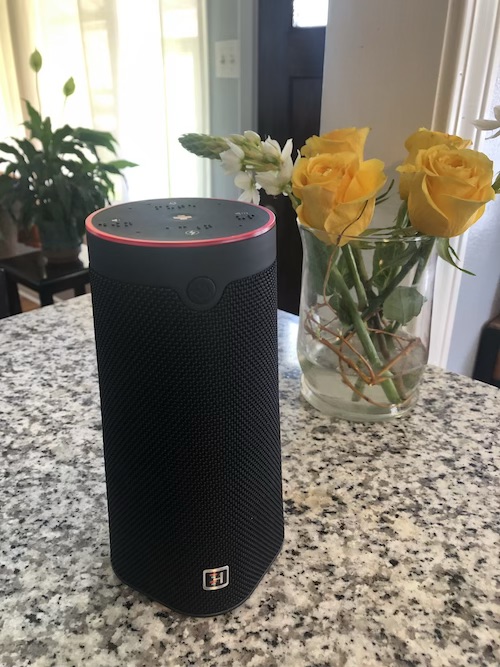
HandsFree Health WellBe Medical Alert Necklace
Insights from our testers
Like the smart speaker, the WellBe Medical Alert Necklace offers 24/7 access to an emergency center and two-way communication with the monitoring center and emergency contacts. As a mobile option, this medical alert system is enabled through 4G and is compatible with iOS and Android operating systems. This model also has GPS, so the monitoring staff can track your location if you have an emergency and you’re out running errands or taking a walk. When testing, we choose the option with fall detection. While this device is less sensitive at detecting slow falls During a slow fall, we wear the medical alert system while sitting in a chair, then bend forward to put our knees on a mat. From there, we lie completely flat on our stomachs for at least 30 seconds. (which the brand notes on their website), it has detected all of our fast falls To test fast falls, we drop each device from shoulder height and let it remain on the mat for at least 30 seconds. , with some test falls triggering the system to initiate a call within three seconds. When you do make an emergency call, either by falling or pressing the emergency button, the device vibrates.
We like that by pressing the buttons on the side of the device, you can ask it questions (like the speaker). However, our testers say they don’t like that setting up the emergency contacts in the WellBe app is difficult, and the monitoring center has been redirected several times during testing.
From our tester
The device allows two-way calls if you are added as an emergency contact, but it seems like you have to be the first emergency contact added.”
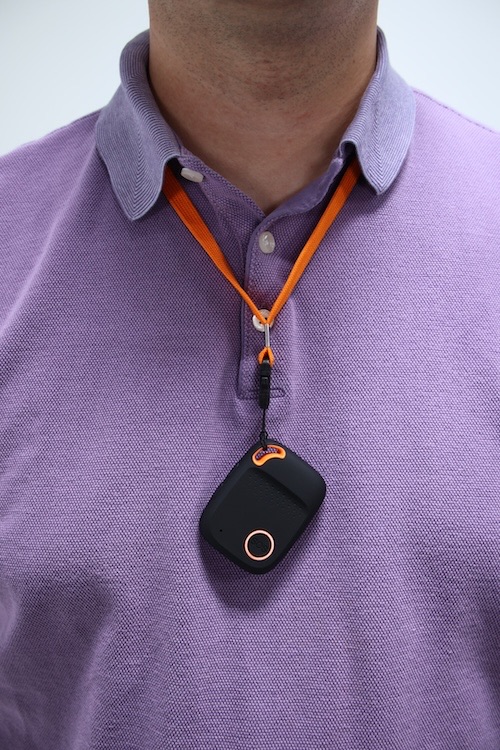
Check out our top picks for the best fall detection medical alert systems for more options.
HandsFree Health WellBe Medical Alert Watch
Insights from our testers
Like the necklace, the WellBe Medical Alert Watch offers optional fall detection and has accurately detected our fast falls with quick response times, but not our slow falls. On average, it takes around 36 seconds to connect with monitoring center staff, and they have accurately pinpointed our location when we’ve tested GPS. We like that when we press the watch, you’re given the option to cancel the call or “call now.” If you don’t do anything, it sends through an emergency call.
This device also offers two-way communication and responds to questions, like “How is the weather?” Plus, we like that you can track your heart rate and steps. However, the watch itself is slightly bulky and heavy, which could make it difficult to wear for long periods or while sleeping.
For more options, check out our roundup of the best medical alert bracelets and best medical alert watches.
From our tester
“The watch did not detect any slow falls, but all of the hard falls were detected with accurate GPS location tracking.”
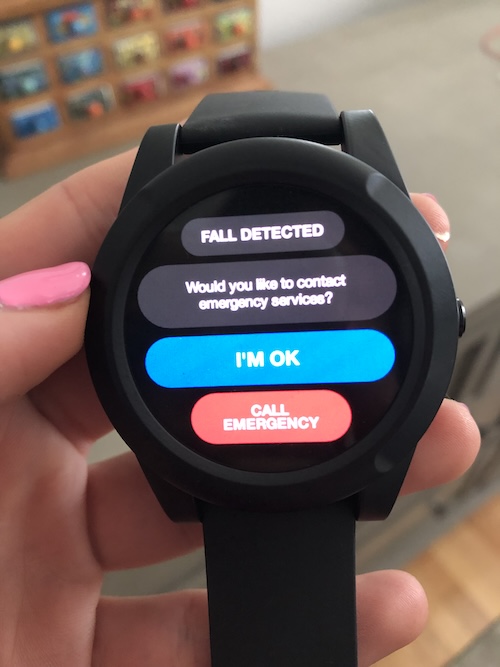
Compare HandsFree Health Models as of October 2024
| Monthly cost | $99.95 for the speaker; 19.95 monthly subscription | $119.95 for the necklace; $29.95 monthly subscription | $159.95 for the watch; $29.95 monthly subscription |
| Battery life | It should always be plugged in, but it can last a few hours with the backup battery | Up to 48 hours with a two-hour charge time | Up to 24 hours with a one-hour charge time |
| Range | N/A | Unlimited | Unlimited |
| Wearable | No | Yes | Yes |
| Health monitoring | Yes | Yes | Yes |
Our testing experience
When shopping for a medical alert system, you can only learn so much information by searching a brand’s website or speaking with a sales representative. You can get a general idea of features, but you won’t know what it’s like to use it. Is it simple to set up the base station? Is the help button necklace comfortable to wear? How easy are the buttons to press?
That’s why we do the testing for you. Based on our experiences, we want to provide the most helpful information about our favorite medical alert systems.
The Handbook Team tested 49 medical alert systems across 14 brands:
- ADT
- Aloe Health
- Bay Alarm Medical
- GetSafe
- HandsFree Health
- LifeFone
- LifeStation
- Lifeline
- Lively
- Medical Alert
- Medical Care Alert
- Medical Guardian
- MobileHelp
- UnaliWear
When choosing medical alert systems to test, we consider well-known brands with a generally positive reputation. Our team picks brands with various pricing options, device designs, and safety features.
Our testing process looks like this:
The Handbook Team reviews a 30-question checklist while setting up and testing each medical alert system. We also follow each device’s user guide and note what is intuitive or difficult about the setup process.
From our tester
“The MobileHelp Classic has super simple directions with large pictures and fonts. The Quick-Start Guide is larger than others and is super simple to follow.”
We spend most of our testing calling the monitoring center since this is the most important feature of any medical alert system. If the device has fall detection, we attempt six additional calls with fall detection tests.
From our tester
“For all fall tests, we wait 60 seconds with the device still on the ground before claiming whether the test was successful. Many fall detection devices don’t register a fall if it’s followed by sudden movement.”
While it’s difficult to duplicate true falls in a test environment, and more real-world fall data is necessary for a standard accuracy rate of fall detection devices, we test fall detection accuracy with a uniform testing method.
Our team conducts three “slow” and three “fast” test falls while wearing the fall detection device. We start all slow falls by sitting in a chair at 90 degrees and dropping to our knees before falling face down on a mat.
For the fast fall, we drop the device from shoulder height to the mat to replicate a fast, hard-impact fall.
“Generally speaking, a hard fall is a fall that can be difficult to stop, happens quickly, and results in a strong impact to the body,” says Sean Marchese, a registered nurse with more than 20 years of experience. “A slow fall is a fall that occurs more gradually, and the impact is likely weaker. However, individuals are not immune to injury after a slow fall.”
If you or your care recipient have a higher risk of falling, Marchese recommends being proactive and speaking with your doctor about assistive devices and prevention strategies.
Our overall thoughts about HandsFree health
What we like about HandsFree Health
HandsFree Health WellBe medical alert systems combine health care with smart technological advancements. From the same device, you can access your medical history, insurance information, appointment and medication reminders, music, audiobooks, and the news. All HandsFree Health devices offer two-way communication to a 24/7 monitoring center and emergency contacts. We appreciate how accurate the fall detection is for fast falls and the speed at which an emergency alert is triggered.
This brand also includes access to the WellBe app, which allows users to manage prescriptions, connect with emergency contacts, and even set non-medical reminders to better organize other aspects of your or your care recipient’s life.
Our Handsfree Health medical alert system complaints
HandsFree Health medical alert systems do not include a comprehensive guide. This makes it difficult to learn the features and specifications of the products without having to look them up online or call HandsFree Health’s customer service team. We also encountered issues connecting to the monitoring center from the medical alert devices, with some calls getting rerouted or interrupted. This could cause serious issues for users in a real medical emergency.
Frequently asked questions
Yes, the Wellbe Medical Alert Watch is water-resistant, so it can be worn in the shower. However, submerging it is not recommended.
The WellBe Medical Alert Speaker costs $99.95, the Medical Alert Necklace costs $119.95, and the Medical Alert Watch costs $159.95. In order to activate your products, you will also need to purchase a monthly subscription from HandsFree Health, which costs $19.95 per month for the speaker and $29.95 per month for the necklace and watch. Read more about the cost of medical alert systems.
The WellBe Medical Alert Watch includes a heart rate monitor, pedometer, GPS location tracking, two-way communication with monitoring centers, a built-in lithium battery, an adjustable strap, and a digital or analog watch face. It also includes 4G cellular data to connect to the WellBe app.
- Ausubel, J. (2020, March). Older people are more likely to live alone in the U.S. than elsewhere in the world. Pew Research Center. Link
- Nathanson, M. (2024, April). Living Alone Can Be Hazardous for Senior Health. Columbia University Irving Medical Center. Link
- MacKay, S., Ebert, P., Harbidge, C., & Hogan, D. B. (2021b). Fear of falling in Older Adults: A scoping review of Recent literature. Canadian Geriatrics Journal, 24(4), 379–394. Link
- Agboola, S., Golas, S., Fischer, N., Nikolova-Simons, M., Buijs, J. O. D., Schertzer, L., Kvedar, J., & Jethwani, K. (2017). Healthcare utilization in older patients using personal emergency response systems: an analysis of electronic health records and medical alert data. BMC Health Services Research, 17(1). Link
- Broadley, R.W., Klenk, J., Thies, S.B., Kenney, L.P., and Granat, M.H. (2018). Methods for the Real-World Evaluation of Fall Detection Technology: A Scoping Review. Sensors, 18(7), 2060. Link






